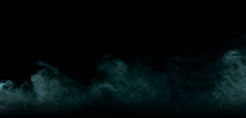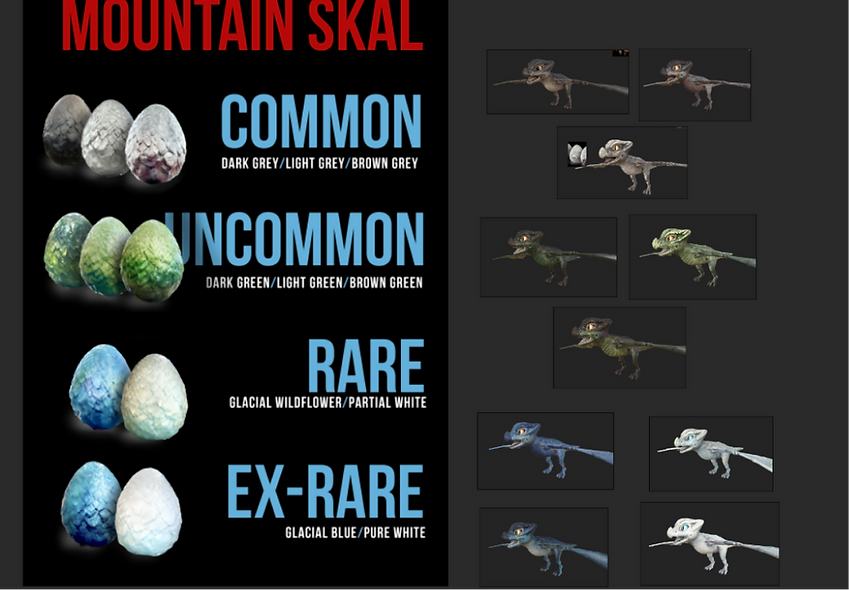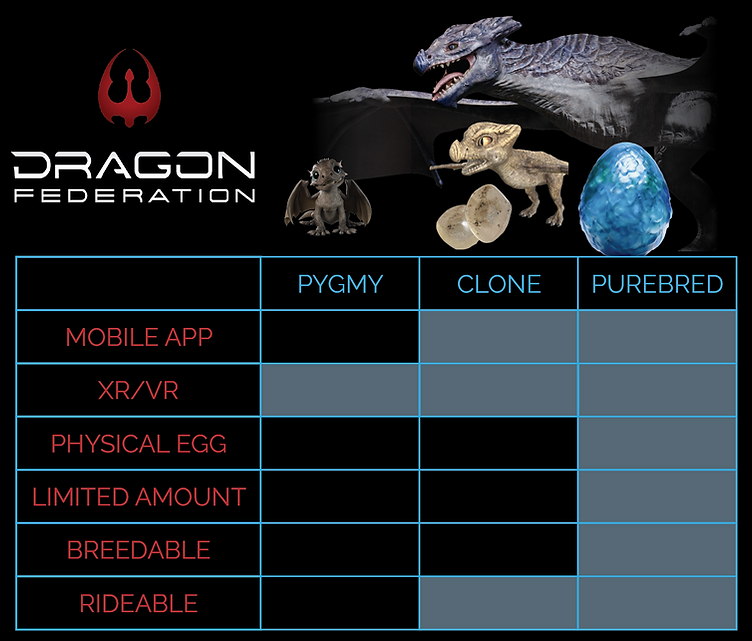
MOUNTAIN SKÁL
MOUNTAIN SKÁL
DRACONIDAE BISALAE WYVERNIS SKAL F. MONTIS
SPECS
Height: 7-8 meters (23-27 feet) or 3.6 meters at rest (12 feet)
Length: 12-15 meters (41-50 feet)
Wingspan: 26-30 meters (85-100 feet)
Weight: 1,100 kg-1,400 kg (2,425 lbs-3,090 lbs).
Body type: Wyvern
Skin type: Scaled
Limbs: 1 pair of back legs, 1 pair of wings
Locomotion: Bi-pedal, Aerial.
Diet: Petrivore, Omnivore
Breeding:
Purebred: Purebred dragons can be bred.
Cloned: Cloned dragons are sterile.
Mobile App Incubation: Approximately 90 Days Gender: Mountain Skál use temperature-dependent sex determination (TSD) to determine the sex of their offspring. Similar to alligators and crocodiles, gender for the Mountain Skál is determined by the temperature during incubation.
Bond Difficulty: Easy
Difficulty:
Purebred: Realistic
Clone: Intermediate
Ridable?: Yes
Lifespan: Dragons live for many human generations. An exact timeframe has yet to be discovered. Dragon Federation is still researching these dragons and information regarding the full lifespan has yet to be discovered. Additional information must be gathered once your dragons have hatched to determine this timeline.
Activity Cycle: Diurnal
Possible Classes:
High Altitude Flier
Fire Breather
Armored Tank
Habitat: Alpine and subalpine regions
Nature Benefit: Harmonic Masonry
Rarity/Colors:
Common: Dark Grey, Light Grey, Brown Grey
Uncommon: Dark Green, Light Green, Brown Green
Rare: Glacial Wildflower, Partial White
Extra Rare: Glacial Blue, Pure White
Cloned: Sand Tan
GENERAL OVERVIEW
The very first dragon breed to approach Dragon Federation, the Mountain Skál are pragmatic and easy-going. They typically have a calm demeanor and are slow to aggression. This particular breed can hone in on evolutionary traits to become capable of spitting fire as an offensive weapon, thicken their scutes (dermal scales), and grow a subdermal layer of muscle and fat to become living tanks or undergo significant mutations to their internal organs and bone structure to allow for high altitude flying.
Mountain Skál are found in alpine and subalpine zones at a range of 4,000 m - 5,000 m (13,000 ft - 16,000 ft) in elevation. They are a hearty breed who’s unaffected by cold temperatures and though relatively docile, both their native habitat and their durability keep most other dragon breeds at bay.
General Appearance and Characteristics: The Mountain Skál is currently the biggest of the dragon types that the Dragon Federation has documented. As this breed advances in age, they can specialize in breathing fire, become extremely tough and durable, or gain an aptitude for flying at high altitudes. These dragons have a predilection for one of the three strengths at hatching, but it has been discovered that certain influences by the trainer, such as what kind of diet is provided to the baby, can alter the skills it learns. These dragons are bipedal; their primary method of locomotion when grounded relies on their muscular back legs to carry their body forward, while the wrist joint and thumb at the apex of the wings are braced against the earth to direct its forward momentum.
The Mountain Skál’s tail is relatively stiff, made up primarily of muscle, and acts as both counterbalance and rudder to control the dragon’s movement.
Mountain Skál weighs less than most standard-sized SUVs and typically ranges between 1,100 kg to 1,400 kg (2,425 lbs to 3,090 lbs). Because of their size and weight, these dragons prefer to take flight by launching off high terrain, though they can get airborne from flat ground if need be. The process is much more difficult, and Riders should tighten themselves into their harness before attempting such a maneuver. Once airborne, however, Mountain Skál are adept fliers and make use of thermal currents, allowing them to soar to exceptional heights. These dragons have developed an ability to control their internal body temperature, allowing them to heat the air around them and thus give themselves more precise control of thermal currents. Mountain Skál that have focused on this adaptation have even greater mastery over flight and seemingly spend more time at high altitudes than they do sleeping or socializing with others of their kind.

EGGS
Mountain Skál eggs are sensitive to their environment and employ a form of cryptic coloration, more commonly known as visual camouflage, to protect themselves if separated from the nest. Chromatophores, cells that produce color, react to the temperature, humidity, and elevation around them to reorient the reflective plates in their structure, shifting the eggshell pigment toward cooler or warmer sides of the light spectrum.
This causes the Mountain Skál eggs to change their native appearance to varying degrees - if the eggs are laid in natural caves, the standard nesting site of the dragons, they will maintain a gray hue. However, if the eggs are somehow transplanted to significantly above or below their typical range, the change in their coloration can be extreme. Since it isn’t common for Mountain Skál eggs to be relocated to such significant distances, the striking differences in pigmentation are the core of the Dragon Federation’s “rarity” classification system. Mother dragons typically nest and lay their eggs in caves in the alpine region of the mountain range they call home. This location is what confers gray variations in the Mountain Skál’s egg shells and is their native hue.
Dragon Federation has loosely grouped these color schemata into the “common” category, which encompasses all versions of dark gray, light gray, and brown gray. While quiet and secluded caverns are the choice site for Mountain Skál eggs to incubate, not all eggs end up in these relatively safe nests. Accidents, seismic events, and water displacement can push single eggs and sometimes even full nests out of their ideal elevation and down into the subalpine and montane regions. Much closer to foliage and soil, these eggs take on shades of green and brown in response to their new environment. This category has been named “uncommon,” and represents all eggs that contain hues of said earthy tones.
Finally, there are the “rare” and “extremely rare” categories. The term “rare” reflects eggs that develop an off-white or a mottled blue and green coloration, while “extremely rare” is reserved for eggs that have taken on azure or pure white pigmentation. These eggs obtain their unique hues from being laid in alpine caves that contain ice deposits.
While Dragon Federation has not yet deciphered the specific conditions that influence an egg into one category or the other, it appears that some elements that contribute are whether or not the egg is bathed in sunlight for any length of time, the depth of the cave it is laid in, and the clutter or lack thereof in the ice surrounding it. Ultimately, any change in hue that occurs to the egg carries over to the dragon upon hatching.
Dragon Federation is still researching the precise mechanism that causes this alteration in the Mountain Skál. Current theories propose that the chromatophores “imprint” their camouflaging behavior onto the color cells of the developing fetus, though this has yet to be proven with any certainty. Whatever the method, this breed of dragon adopts its egg color as its base scale color. There seem to be no genetic or chromosomal differences in the various Mountain Skál pigmentations, nor do these characteristics interfere with breeding. The changes in coloration appear to be solely visual, and no distinctive behavioral or dietary changes based on these pigmentations have been observed.
While the color of the egg becomes the Mountain Skál’s base complexion, the hue can shift and grow more or less vibrant as the dragon ages. Additionally, the unique patterning of each Mountain Skál may also fluctuate over time, changing in size and shape. However, the base pigmentation of these dragons can be temporarily altered to extremely divergent tones by various external stimuli such as diet. These alterations will remain only for so long as the Mountain Skál continues to consume the color-modifying substances.
Incubation: Varies. In the wild when environmental factors are optimal, However, due to a myriad of complicating factors, Mountain Skál eggs in the Dragon Realm have not hatched naturally for a very long time. Dragon Federation has created an incubation system and vital-reading application to assist in the incubation of these eggs. When properly cared for, Mountain Skál eggs can be expected to hatch in approximately 90 days.
BEHAVIOR AND TEMPERAMENT
The Dragon Federation lovingly refers to these dragons as the “gentle giants” of the Dragon Realm. This breed is known for its calm and even temperament and has so far been the most friendly toward humankind. They treat one another with a similar approach, and it isn’t uncommon to find an elder dragon playing “jungle gym” with a pack of hatchlings.
Mountain Skál are most commonly found together in a large grouping known as a weyr. These dragons are a communal breed and generally travel together. Unlike humans, however, the Mountain Skál are less welcoming when it comes to other dragon breeds. The Mountain Skál are not proactively aggressive, but they will viciously defend their territory from invading dragons. Equipped with the ability to bite through rock and smash boulders with their tails, Mountain Skál are more than capable of making even the fiercest beast think twice before bothering them.
Social:
Mountain Skál are mainly herd animals that appear to be organized by regions. Young hatchlings seem to require interbreed socialization. More details coming soon.
Mood:
Being a creature possessed of intellect, the Mountain Skál is capable of a wide range of emotions. However, they are highly disposed to contentment. This dragon doesn’t need much more than a sizable boulder and a dry place to sleep to be happy, and it expresses its pleasure with a low, rumbling sound much akin to a cat’s purr.
Mating:
Dragon Federation is currently participating in ethological studies on this topic and will publish an update to the when more information has been acquired.
DIET AND HABITAT
The internal temperature of the Mountain Skál can swell upwards of 650 degrees Celsius (approximately 1200 degrees Fahrenheit) as they primarily consume granite. The mix of intense pressure, heat, and unique enzymes in the digestive system break down the ingested stone to fuel the Mountain Skál. These dragons can be omnivorous if the situation calls for it and are capable of subsisting off meat and vegetation, but their primary sustenance is the limestone and granite of the mountain vistas they call home.
Due to the internal heat produced by their digestive process, Mountain Skál tends to gravitate toward mountain peaks and glaciers to mitigate their high core temperature. This breed can also occasionally be found in deep caves or other cool and wet locations, but their primary territory is within the alpine and subalpine zones of mountainous regions.
CLONED
Due to how long it takes to hatch and raise a Mountain Skál from infancy to breeding age, Dragon Federation has turned its attention to additional projects in the hope of staving off the extinction of these magnificent creatures. One of these projects has proven fruitful: cloning. Cloning is the process of producing individual organisms with identical genomes, either by natural or artificial means.
Cloned Mountain Skál are nearly identical to their natural-born counterparts, but because cloning is still an imperfect science, there are a few variations between the two. All Mountain Skál Clones are a sand-colored hue, and they are all sterile and thus cannot breed. With the exception of those two traits, Mountain Skál Clones are identical to the native Mountain Skál of the Dragon Realm.
THREATS
Dragon Federation is currently participating in ethological studies on this topic and will publish an update to the bestiary when more information has been acquired.
CARE
Updates will be posted in the Dragon Federation: Monitor found in Apple App Store and Google Play Store for AR capable devices.











